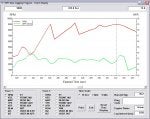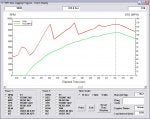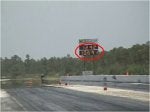I spent the better part of Saturday with Chris Schroeder from Daytona Twin-Tec. We installed the VRFI (V-Rod Fuel Injection) closed loop system on my bike today. :dance:
For a little background, Chris has been in the high performance after market business for the last 20+ years. Prior to forming Daytona Twin-Tec 4 years ago with his partner, Allen he spent 10 years as the chief engineer for Crane Cams. Chris is the engineering brains behind the operation, he writes all the software and designs all the products they sell. All of the products are built through contract manufacturing with final assembly being performed at their shop in Daytona. The TCFI / VRFI is licensed technology. They own the exclusive rights to produce and sell this product from the original designer and patent holder. All of the bike specific firmware is written in house by Chris.
Initial impressions:
The hardware installation is about a 1 hour job taking your time. The entire project will take the better part of a day. The steps are spelled out in their installation manuals on their site, http://www.daytona-twintec.com/VRFI.html. I've also spelled out the steps farther down in this post.
Now, for the performance review. THIS THING ROCKS! The bike has NEVER run this smooth and had this much power at every point in the power band. There is absolutely NO deceleration popping or surging at any RPM that I can detect. I actually scared myself rolling on power in 3rd gear at 4000 rpm. The bike jumped forward so fast that I wasn't ready for it. It's always had a minor flat spot in the mid range that caused a little hiccup, that's GONE!
Another thing I noticed is the motor is smoother across the entire power band. I can't explain it but with the Delphi unit I picked up resonant vibrations at various rpms. With the VRFI there are NO vibrations at any RPM in any gear. This one has me baffled and I need to get some more miles on this thing to make sure I'm not losing my mind.
PLEASE NOTE This is a new unit (although the technology is proven on the air cooled Delphi bikes). The Alpha unit on Chris' bike only has about 500 miles on it so we need to get a few more miles on this before it's taken out of "Beta" test and released to the general public.
As with all things in life nothing is perfect. There are 2 very minor issues I have with the unit (actually they are related)
For those who are interested and don't want to read the instruction manual Here are the steps:
Now that it's installed you need to start the auto tuning process.
From here you need to calculate the rear cylinder trim.
Here's some things that I need to do:
For a little background, Chris has been in the high performance after market business for the last 20+ years. Prior to forming Daytona Twin-Tec 4 years ago with his partner, Allen he spent 10 years as the chief engineer for Crane Cams. Chris is the engineering brains behind the operation, he writes all the software and designs all the products they sell. All of the products are built through contract manufacturing with final assembly being performed at their shop in Daytona. The TCFI / VRFI is licensed technology. They own the exclusive rights to produce and sell this product from the original designer and patent holder. All of the bike specific firmware is written in house by Chris.
Initial impressions:
The hardware installation is about a 1 hour job taking your time. The entire project will take the better part of a day. The steps are spelled out in their installation manuals on their site, http://www.daytona-twintec.com/VRFI.html. I've also spelled out the steps farther down in this post.
Now, for the performance review. THIS THING ROCKS! The bike has NEVER run this smooth and had this much power at every point in the power band. There is absolutely NO deceleration popping or surging at any RPM that I can detect. I actually scared myself rolling on power in 3rd gear at 4000 rpm. The bike jumped forward so fast that I wasn't ready for it. It's always had a minor flat spot in the mid range that caused a little hiccup, that's GONE!
Another thing I noticed is the motor is smoother across the entire power band. I can't explain it but with the Delphi unit I picked up resonant vibrations at various rpms. With the VRFI there are NO vibrations at any RPM in any gear. This one has me baffled and I need to get some more miles on this thing to make sure I'm not losing my mind.
PLEASE NOTE This is a new unit (although the technology is proven on the air cooled Delphi bikes). The Alpha unit on Chris' bike only has about 500 miles on it so we need to get a few more miles on this before it's taken out of "Beta" test and released to the general public.
As with all things in life nothing is perfect. There are 2 very minor issues I have with the unit (actually they are related)
- It does not use the Ion Sensing circuit for detonation sensing and spark retard. It's a combination of a patent issue with Delphi as well as a technical issue with the sensing circuit itself (very low signal to noise ratio)
- The spark tables are currently based on standards for motors of this type and power rating. Without the Ion Sensing it's going to be tougher to fine tune them.
For those who are interested and don't want to read the instruction manual Here are the steps:
- Remove Factory ECM
- Replace with VRFI unit
- Install WEGO unit
- Install ground for WEGO on main engine ground under airbox, this takes the most time because you have to remove the airbox to get to it.
- Tap fuse box for switched power
- Velcro unit on top of battery
- Perform free air calibration of O2 sensor
- Install O2 sensor on front pipe (assumes you already have the pipe prepped with a bung)
- Connect WEGO to ECM by adding a pre-wired pin to position #8 in the ECM connector
- Tidy up wires but leave the wire to the O2 sensor outside so it can be moved to the rear for the trim adjustment
- Power up bike with the run/stop off
- Switch to run and leave it for 5 seconds, Switch to stop then back to on and leave it for 5 seconds
- Start bike and observe proper idle, If it doesn't idle correctly then shut down and perform throttle body sync and TPS adjustments (not needed on my bike or most stock bikes)
Now that it's installed you need to start the auto tuning process.
- That consists of multiple runs going through as many throttle position / RPM ranges as you can manage.
- After each session you plug the bike in and take a look at the Block Learn Multiplier (BLM) table.
- The values should be from 95 to 105, if there are swings outside this range then you "apply" the BLM table to the Alpha-N table to update the base map. That zero's out the BLM making it ready for your next tuning pass.
- Once you see all (or most) of the BLM values within the 95 - 105 range you have achieved a very good base tune.
From here you need to calculate the rear cylinder trim.
- Open the PC-Link software and change the sample rate to .1 or .2 seconds and uncheck the "Closed Loop" option. That keeps the bike in open loop and simply logs the AFR readings
- Move the O2 sensor to the rear pipe (remembering to plug the front hole)
- Make many short runs trying to get as many samples in as many TPS/RPM cells as possible. It take short runs here because of the small sample rate. The internal memory can only hold 3 minutes of data at a rate of one sample every .1 seconds.
- After EACH RUN you need to plug the bike in and upload the AFR table onto you PC. Each run will be a separate file
- Once you have made a significant number of runs you now need to combine these files and allow the system to calculate a rear trim value for each TPS/RPM cell. This is done within the software and you need to review the results and smooth the data for un-logged cells.
- Save the rear trim into the master map file
- Reset the map parameters to a .5 second sample rate and check the "Closed Loop" operation option
- Save this file then download it into the ECM
- Move the O2 sensor back to the front pipe (remembering to plug the rear hole)
Here's some things that I need to do:
- Perform the rear cylinder trim, I'm using the values from his bike with the SuperTrapp. It shouldn't be that much different but I need to do it regardless.
- Clean up the wiring once that's done to hide the wire going to the sensor
- Get some more miles on the unit to really see how it handles various situation.








